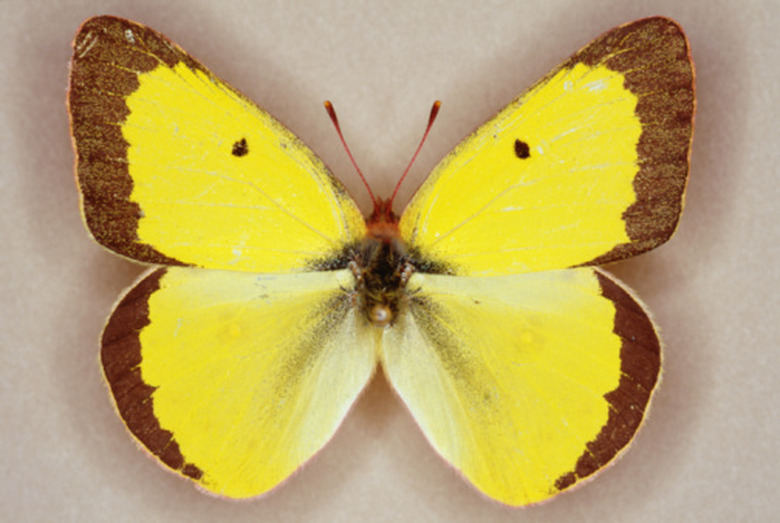Butterfly Skeletal System
Like almost all insects, butterflies are protected by an external skeleton. Unlike humans, whose bones are beneath soft tissues forming an endoskeleton, the soft tissue of butterflies is encased in a hard shell called an exoskeleton. The exoskeleton of most insects, including butterflies, is made of a bone-like material called chitin, which varies in thickness depending on the vulnerability of the organs it protects.
Head
Head
The exoskeleton of a butterfly in the head region functions like the skull of a human being. The hard shell protects a tiny brain. Openings in the exoskeleton leave space for the eyes, proboscis and antennae. Unlike humans, butterflies have no soft tissue covering the chitin of the head. Here, chitin is thick, though not as thick as the covering of the abdomen.
Thorax
Thorax
The shell housing the thorax, or the butterfly's upper body, protects the muscles that power the insect's wings. The butterfly's body is so tiny compared to the bodies of creatures with endoskeletons that an exoskeleton is a great evolutionary advantage. If exposed, the muscle tissue of the butterfly's thorax could be crushed at the slightest touch from a larger organism.
Abdomen
Abdomen
The exoskeleton that protects the butterfly's abdomen is segmented and connected by soft tissue, allowing for motion. This portion of the butterfly's protective shell is made up of 10 pieces that interlock and flex like a suit of armor. Each of these pieces is shaped like a ring, and made from chitin that is thicker than anywhere else on the butterfly's body. This is the hardest portion of the butterfly's exoskeleton, since the abdomen houses essential organs used in egg laying and digestion. Since reproduction requires flexibility, the chitin is more complex than the solid sheets of material that form the rest of the exoskeleton in its ability to flex.
Wings
Wings
The butterfly's exoskeleton extends to cover its delicate wings. Here, however, the protective covering becomes extremely thin and takes the form of tiny, plate-like scales. These scales resemble dust to the human eye and are easily dislodged from the butterfly's wings. The material that comprises the butterfly's scaly wings is called the chitonous layer. It is especially light since a heavy exoskeleton on the wings might make them more durable but would prohibit flight.
Cite This Article
MLA
, Emma Rensch. "Butterfly Skeletal System" sciencing.com, https://www.sciencing.com/butterfly-skeletal-system-8568936/. 22 November 2019.
APA
, Emma Rensch. (2019, November 22). Butterfly Skeletal System. sciencing.com. Retrieved from https://www.sciencing.com/butterfly-skeletal-system-8568936/
Chicago
, Emma Rensch. Butterfly Skeletal System last modified August 30, 2022. https://www.sciencing.com/butterfly-skeletal-system-8568936/
